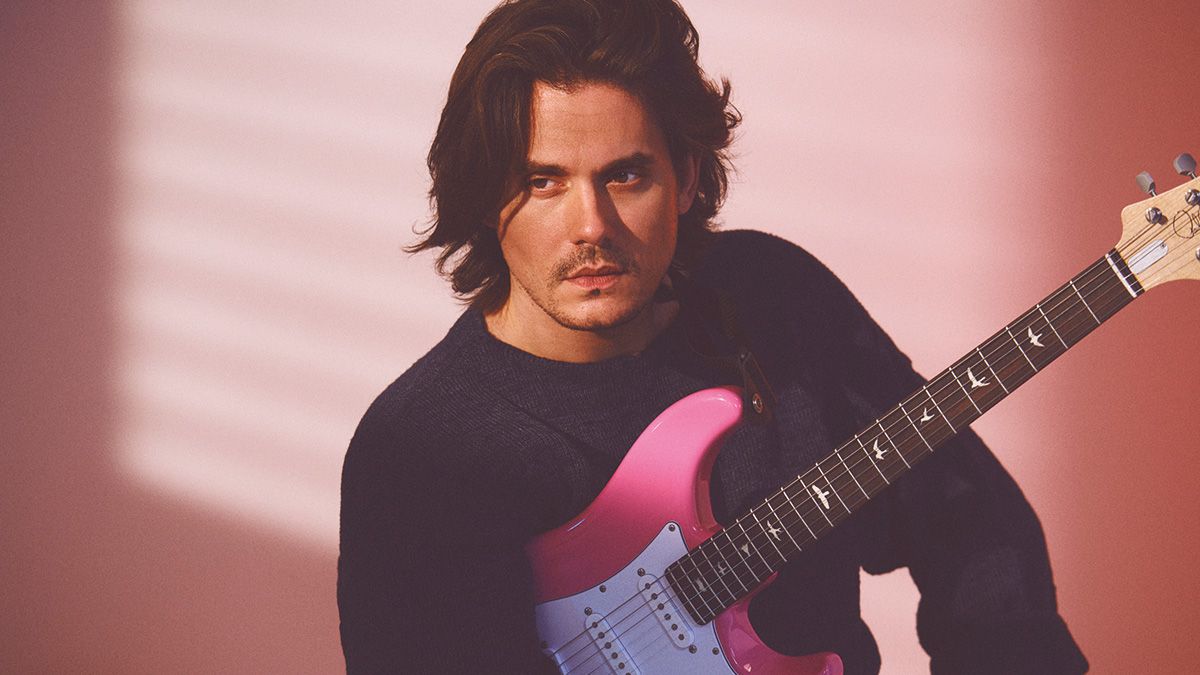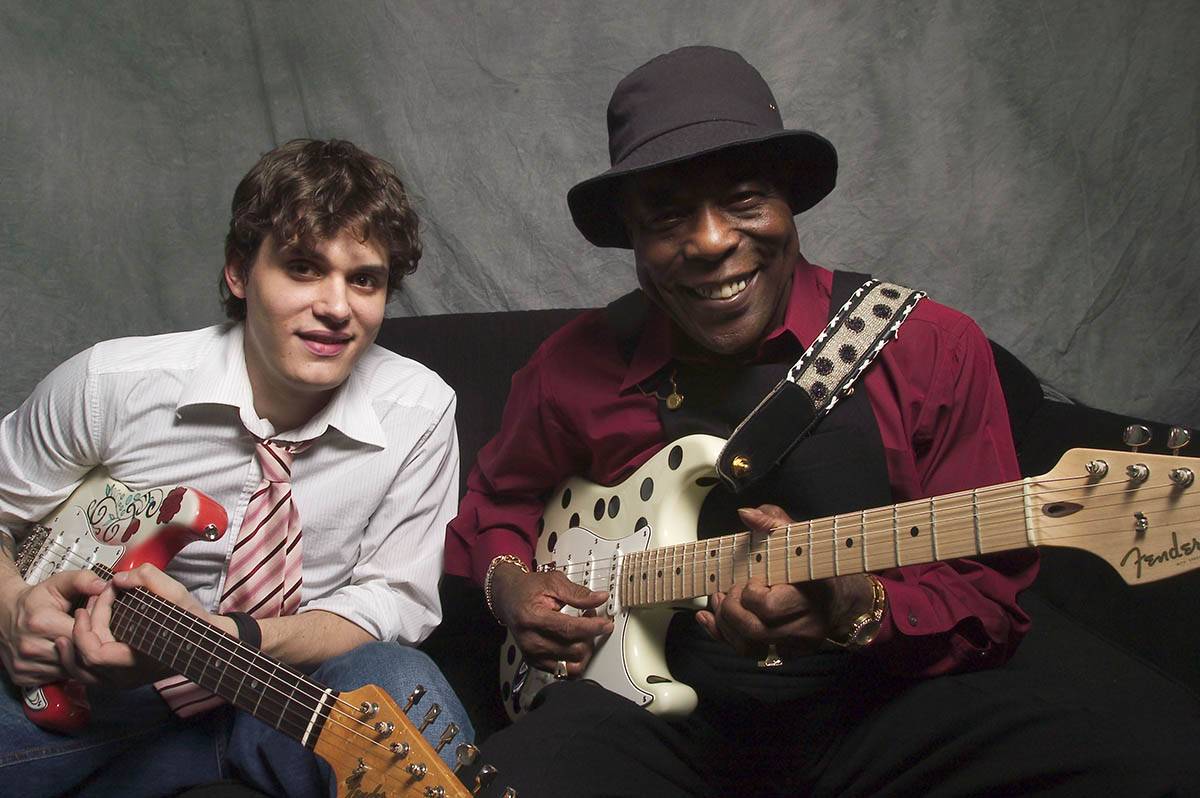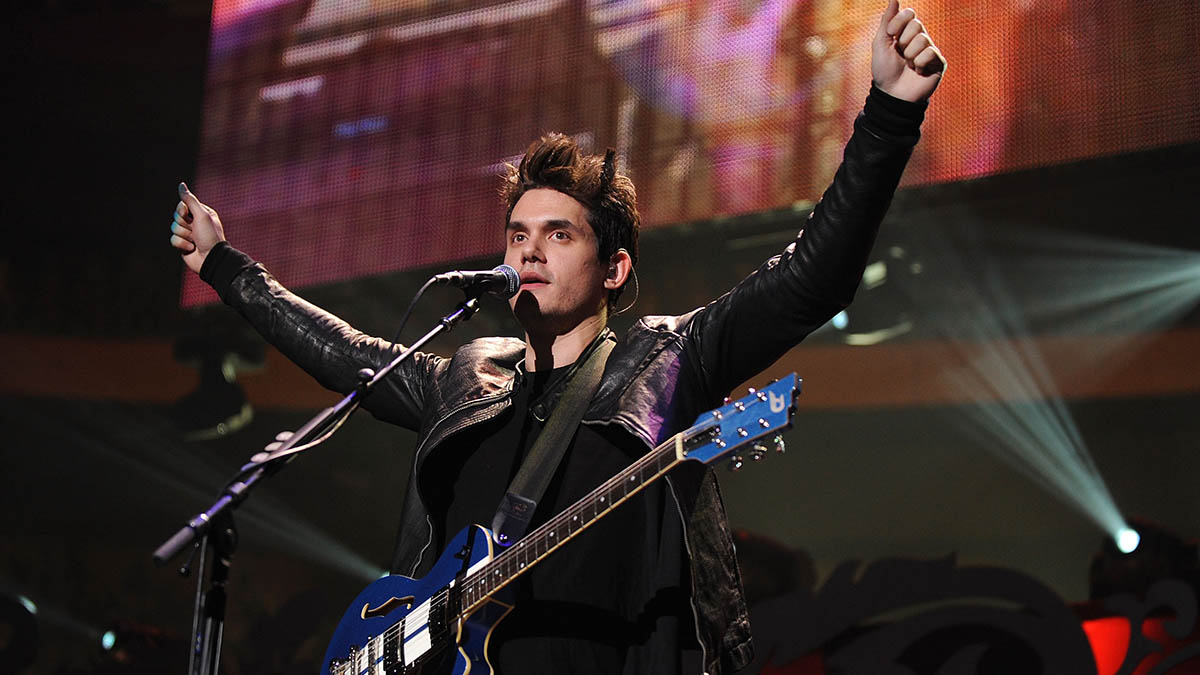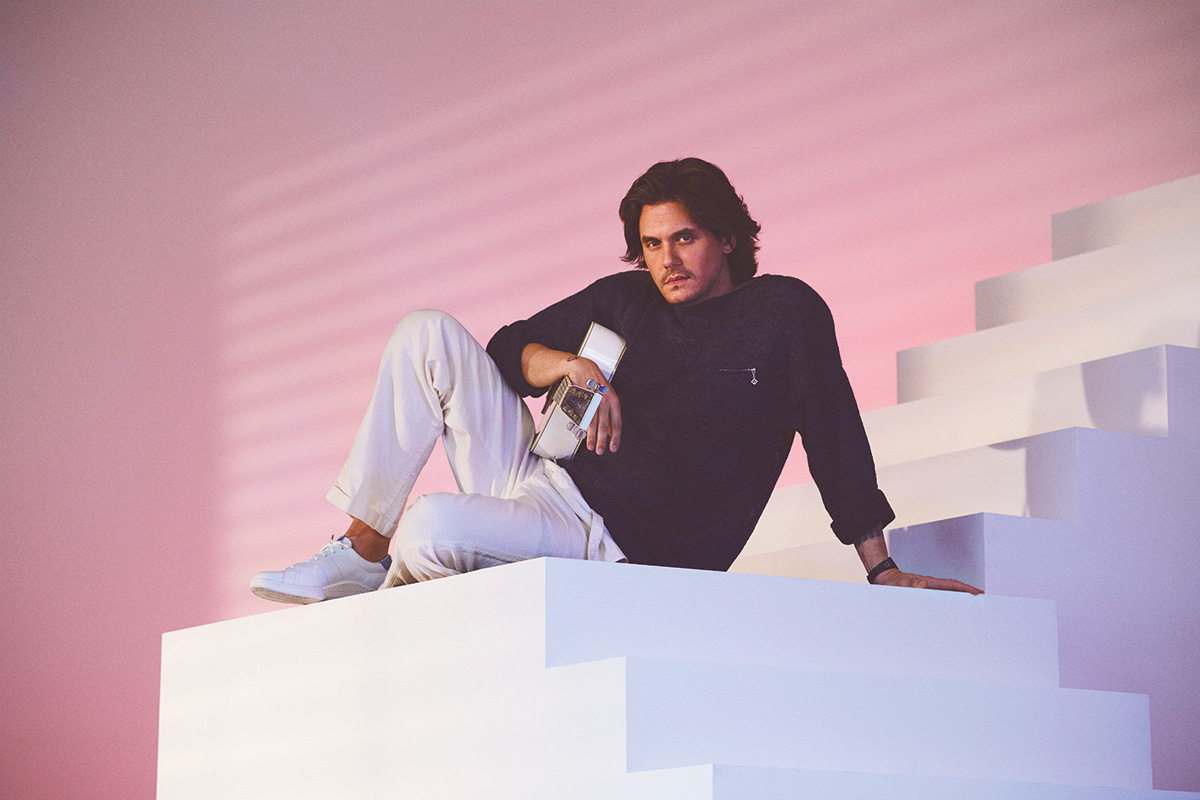How John Mayer conquered the world
Inspired by Stevie Ray Vaughan and feted by Clapton, John Mayer is one of the most gifted guitarists of the modern era. This is his story

In March 2021, when John Mayer used TikTok to preview a snippet of Last Train Home – the flagship single from his new album Sob Rock – it was a typically smart move.
Since the prehistoric age of MySpace, Mayer has always embraced social media. He’s a shrewd guy who knows the game, and in his two decades of stardom he’s accrued 5.2 million followers on Instagram, 1.4 million on Twitter and 1.2 million on TikTok. Clearly, his global fanbase stretches far beyond the guitar community.
But dig down – past the meme-friendly videos of his dogs swimming in his pool, the pastel-shaded, 80s-vibe promo shots for Sob Rock, and the numerous photos of celeb friends such as Ed Sheeran, Herbie Hancock and Barbra Streisand – and you’ll find some videos in which he offers sage advice on the art of guitar.
Some tips are immediately practical: don’t start your solo too high or you’ll have nowhere to go; to play great blues guitar, listen to the phrasing of great blues singers.
Others take more skill to implement – such as choosing notes within your solo that imply the chord changes behind it – while his most advanced musical philosophy has echoed down the ages through countless other great guitarists: “Practise thinking from the idea first,” he advises, “instead of what the guitar offers you.”
To be a true musician, then, think beyond your scale boxes and your muscle memory – hear the melody in your head first and play that. All the while tap your foot in time and imagine the chord progression, the band, behind you.
That’s what Mayer does, and things have worked out nicely for him. His 2001 debut album Room For Squares went five times platinum in the US and earned him the first of his seven Grammys to date.
Get The Pick Newsletter
All the latest guitar news, interviews, lessons, reviews, deals and more, direct to your inbox!
It also introduced the world to an unusual talent, someone who straddles the camps of commercial pop and also blues/rock music like no other modern star. With his pop savvy, his smooth, pillow-talk vocal style and Johnny Depp-level movie star looks, Mayer didn’t just dip a toe in the mainstream, he cannonballed straight into it.
This modern-day guitar virtuoso/vocalist/songwriter has three US Billboard No.1 albums under his belt, can fill arenas across the world, and is also regularly invited to cameo with some of modern music’s most recognisable stars: Sheeran, Jay-Z, Alicia Keys; he’s even dated some of them, notably Taylor Swift and Katy Perry.
And he’s not afraid to shower irony-free praise on Justin Bieber for his melodic gifts, or on Dua Lipa for her rhythmic hooks. But while he has an eye on the poppier realm, it’s telling that Mayer was also speed-dial buddies with Apple’s Steve Jobs – because this talented, handsome, successful guy is also a bit of a nerd.
Along with his geeky passion for watches, design and fashion, his fastidious, obsessive nature is evident in his detailed posts about guitar playing – and his massive guitar collection.
He can happily expound on the relative merits of different six-strings, cables and amps, right down to the attributes of certain tube brands. He was hands-on at the Fender Custom Shop for the production of his beloved ‘Black1’, the Relic Strat strapped to him on the cover of his 2003 US No.1 album, Heavier Things.
He’s a master. His facility is phenomenal. I don’t think he even knows how good he is
Eric Clapton
10 years later and about to embark on his first tour with remaining members of the Grateful Dead, he approached luthier Paul Reed Smith to make him a guitar. Mayer went to the PRS factory personally and sifted through every pickup, neck and component, in the quest for the exact right tool for the job.
And just as he will gladly join those A-listers of pop, rap and RnB, Mayer’s equally comfortable ripping it up with legends of the blues, such as BB King, Buddy Guy and Eric Clapton. “He’s a master,” Clapton said of Mayer recently. ‘His facility is phenomenal. I don’t think he even knows how good he is.” It was the blues that got him into all this.
Born in 1977, Mayer grew up in Fairfield, Connecticut. As a child of the '80s he was welded to MTV, soaking up all the slickly produced, deftly played soft rock, yacht-rock, MOR and AOR the new-fangled channel could offer.

Among the artists soundtracking his youth were Clapton (in his shoulder-padded pomp, enjoying a renaissance with hit albums August and Journeyman) plus Toto, The Police, Huey Lewis & The News, Phil Collins (in Genesis and solo), Elton John and Steve Winwood.
When Mayer was 13, a friend gave him a mixtape featuring the blistering Texas blues of Stevie Ray Vaughan & Double Trouble, and he was hooked. Vaughan’s MTV-friendly image and rocky take on the blues offered a perfect entry point into that world for a white teenager from the suburbs, and opened the door to Jimi Hendrix, Cream/Bluesbreakers-era Clapton, Buddy Guy, Bonnie Raitt, Robert Cray and the three Kings – BB, Albert and Freddie.
His dad rented him an acoustic guitar from a local music store and he took lessons. He played obsessively, emulating his heroes, soon learning the language of the blues on his first electric, a Squier Strat.
His teenage power trio, Another Roadside Attraction, played amped-up blues covers à la SRV, and by the time his next group, Villanova Junction, was playing dances at Fairfield High School circa ’96, he had saved enough to buy himself a Stevie Ray Vaughan Signature Strat, his main axe for years.

Landing a place at the prestigious Berklee College Of Music, he looked around and no longer hankered to be the best guitarist in the room, and realised he didn’t want to make music just for the enjoyment of other musicians.
His ambitions were to reach a wider audience, and he worked hard on his songwriting, heavily inspired by the meaningful, modern-classic approach of the brilliant singer-songwriter and pianist Ben Folds.
Speaking to Oxford Union years later, Mayer said of Folds: “He made songwriting feel so exciting to me. I said, ‘Stop everything – I want to be able to put that much personality into music through songwriting’.”
Mayer barely lasted a year before ditching his studies to try his luck on the coffee shop/club circuit in Atlanta as one half of Lo-Fi Masters, with fellow Berklee dropout Clay Cook.
With Mayer strong-minded and intent on pursuing a pop/popular course, he split from Cook and gigged relentlessly to establish a solo career, plugging in his Martin OM-28 acoustic alone on Atlanta’s small stages, fostering his fanbase, shrewdly encouraging his followers to spread the word by sharing his songs on Napster. He went viral, and when real success came, it came fast.
His self-released 1999 EP Inside Wants Out led to a showcase gig at South By Southwest Festival, he subsequently signed his record deal with Aware, a sub-label of Columbia Records, and in 2001 – a mere five years after he bought that SRV Strat – Room For Squares set him on his present, stellar course.
It’s easy to underestimate the musical intelligence and taste at work beneath Mayer’s brand of radio-friendly pop-rock.
The relatively conventional Your Body Is A Wonderland was the breakout hit (384 million Spotify hits and counting), but Room For Squares also features Neon, a great example of the fingerstyle technique that’s one of the powerful weapons in Mayer’s arsenal (redeployed regularly, notably on fan favourites Stop This Train and Who Says).
With his OM-28’s low-E tuned to C and the other strings standard, he fingers Neon’s oddly voiced Cm/Eb/Fm/Ab/Bb chords with his huge fret-hand thumb over the top to fret the bass notes.
His right hand uses a twist on the clawhammer picking technique: thumb and forefinger pick the notes alternately, the thumb’s percussive slap on the low C giving the song its propulsive rhythm.
It’s a remarkable musical and physical feat, and a technique that has seeped into the modern acoustic player’s lexicon. As influential as it’s been, Neon is hard to emulate well.
“Having giant thumbs helps,” Mayer wrote dryly, when later tabbing the song. His first US No.1, second album Heavier Things had a broader palette, with horns, loops and synths, and Mayer’s Strat more to the fore – the chiming intro chords of Something Else, choppy rhythm of New Deep; the notably gutsy solos on country-like ballad Come Back To Bed and soft rocker Only Heart.
These early records only hinted at Mayer’s deep skill and ear for blues-infused electric guitar, but during his first major tours critics and fans alike soon realised he was a serious player. Word spread, and guest slots soon came with artists such as Buddy Guy, BB King, Derek Trucks and one of Mayer’s songwriting heroes, Paul Simon.
Such cameos would pepper his whole career, and whether trading licks with Guy, King or, later, Clapton, the rising guitarist lapped up every opportunity to learn from his heroes. “When you’re on the same stage as they are,” he once observed, “and in the same moment, it’s such an unbelievable lesson in what to do when.”
His credibility and confidence received a major boost in 2004, when he was invited to join Guy, King, Jeff Beck, JJ Cale, Steve Vai and other big names on the bill of Clapton’s all-star Crossroads Guitar Festival in Dallas, Texas. And that year, a new member of his crew would bring him even closer to his childhood hero, the man whose three initials he has tattooed on his left shoulder.
René Martinez had been Stevie Ray Vaughan’s guitar tech from 1985 until the guitarist’s tragic death in 1990. 13 years later, he was working with Carlos Santana and on the verge of retirement when a producer mentioned this hotshot new guitarist doing the rounds, and Martinez was subsequently offered a job tech’ing for Mayer at just a few shows.
When the veteran engineer heard the twentysomething play at soundcheck he was genuinely blown away. He delayed his retirement and went on to tech for Mayer for the next 15 years, until finally hanging up his soldering iron in 2019.
“John is a true guitar player,” Martinez once said, and he knows one when he hears one. “He’s one of those guys who has a lot of respect for me and vice versa. I know my guitars so well and he knows that I do. He just lets me at it.”
When asked on Twitter in 2017 what he did to new guitars as soon as he got them, Mayer simply replied, “I hand them to René. It’s not my guitar till he touches it.”
By 2005, one of those guitars was the Fender John Mayer Signature Stratocaster, a real moment of arrival at the time Mayer was coming of age as a player. He formed his own trio, completed by virtuoso drummer/producer Steve Jordan and Welsh bass great Pino Palladino.
Having supported The Rolling Stones during their A Bigger Bang tour, the John Mayer Trio released their electric live album, Try! – recorded at the Chicago House Of Blues. Opener Who Did You Think I Was blended Mayer’s songwriting smarts and the rhythmic, neck-pickup blues fire learned from Vaughan.
Along with a read of hit-to-be Gravity and his Grammy-winning, crowd-pleasing waltz-time ballad Daughters, the trio gave a funky, full-bore cover of Wait Until Tomorrow (from Mayer’s favourite Hendrix album, Axis: Bold As Love) and Ray Charles’ I Got A Woman (newly popular thanks to Kanye West sampling it on his Gold Digger, a global hit that year). The trio toured North America, Mayer loving the space the three-man format afforded him.
With Jordan and Palladino both masters of their instruments, the guitarist had to raise his game. He found himself playing at the peak of his own abilities, and occasionally surpassing them. He was growing, and after the dizzying, vertical lift-off of his career, was learning to be open to musical discovery again: “The trio opened up that part of my brain I was waiting on, that next phase in my mind.”

Completed in the trio’s afterglow and produced by Jordan, 2006’s double Grammy-winning Continuum benefitted from the newly acquired maturity in Mayer’s playing, with the electric guitar – and those blues and soul influences – more prominent in the mix.
Along with the accomplished, light-touch cover of Hendrix’s Bold As Love, he played soulful pentatonic lines on three classic entries to his catalogue: the studio version of Gravity (over 250 million Spotify hits thus far), Waiting On The World To Change (259 million) and – with its mellow, minor-key harmony guitar hook – the romantic Slow Dancing In A Burning Room (304 million, and climbing – these are Sheeran-level stats).
The film of the Continuum tour, 2008’s Where The Light Is: Live In Los Angeles featured three sets – acoustic, trio, full band – and showed the strength of Mayer’s growth across the board, in less than a decade. By comparison, 2009’s Battle Studies was relatively restrained, but the guitarist’s fire burned through in parts.
As with the simple lines and Neon-style picking of Continuum’s The Heart Of Life, Friends, Lovers Or Nothing evoked the sounds of another early influence, the Beatles’ George Harrison. To the popular audience, the album is best known for its memorable hit single Heartbreak Warfare and Half Of My Heart, Mayer’s smooth, Fleetwood Mac-worthy duet with then-girlfriend, Taylor Swift.
But guitar highlights abounded, too: the gorgeous slide solo on sad, simple All We Ever Do Is Say Goodbye; bluesy major-pentatonic blues of Perfectly Lonely and that cheeky picking masterclass, Who Says. Such tasteful acoustic playing was a cornerstone of his next US No.1 album.
Exquisitely co-produced by Don Was, Born And Raised (2012) saw Mayer change tack again, delving into the dusk-dappled 70s Americana of Laurel Canyon. Crosby, Stills & Nash and Neil Young were notable influences. David Crosby and Graham Nash even sang on the title track, and with its lyrical reference to Young’s classic LP After The Gold Rush, Queen Of California’s downhome, bluegrassy motif – a fingerstyle, mixolydian-flavoured riff around a B7 chord.

The echoes here of JJ Cale’s nice ’n’ easy vibe continued on follow-up Paradise Valley. Along with a spot-on cover of Cale’s classic Call Me The Breeze, Mayer cooked up tasty harmony slide parts (Waiting On The Day), sparse and soulful soloing (Paper Doll), with vocal turns from his then-partner Katy Perry (duet Who You Love) and neo-soul star Frank Ocean (Wildfire).
To gauge the sheer scale of his success and connection with an audience by this point, take a look below at John Mayer Dear Marie Rock In Rio 2013 on YouTube. Coming in 2017, his third US No.1 album, The Search For Everything, was one of his most eclectic, a quasi-concept piece broaching everything from Mayer’s standard uptown soft rock (three-chord hit Love On The Weekend – G, C and the occasional D spun into radio gold), to You’re Going To Live Forever In Me – a charming, melancholy spin on Randy Newman’s child-friendly, adult-complex music for the Toy Story movies.
In one interview while touring the album, Mayer gave an eloquent, revealing insight into what actually occurs in the mind of an elite guitarist while soloing: “Streams of possibilities – shapes, what’s where and where does it go. I’ve done it so long now that a lot of that data has dissolved and it’s all feeling now. I just know where it is. It’s very Jedi.”
All of Mayer’s Force powers are required for his ongoing gig alongside guitarist Bob Weir and other members of legendary US psychedelic rockers, the Grateful Dead. Their catalogue of live recordings is large, and larger yet is their reputation for long, raggedly glorious extemporisations drawing on rock, blues, jazz and country.
Lead guitarist and singer Jerry Garcia, who died in 1995, remains a musical icon and cultural figurehead to legions of Deadheads across the world, to whom the band’s music is sacrosanct. Mayer had long loved their concert regular Althea, with its languid groove, and hypnotically repetitive Bm/A/E verse, particularly the snatchy, woozy recording cut live at Nassau Coliseum in 1980.
Over 20 years later, he struck up a friendship with Weir after a TV show, and was invited to join the ranks of Dead & Company, touring the Dead’s music across the US.
Given Garcia’s standing, Mayer was initially worried about the reception he’d get from the fans, and whether he’d be able to adapt his own style and keep up. “It would take six guitarists to accomplish what Garcia did,” he said later. “You really have to think on your feet in a number of axes at the same time.” But Weir had confidence in him, and Mayer took on the challenge.
Dead & Company’s first 2015 run was a success and they’ve gigged every year since. Garcia’s distinctive midrange, middle-pickup sound owed much to ‘Wolf’, his custom-made Alembic guitar, and with this in mind Mayer reached out to Paul Reed Smith personally to collaborate on a model he could use for the Dead gig.
They came up with the PRS Super Eagle – an ultra high-end, boutique instrument (only 100 ever made). The equally exclusive Super Eagle II followed in 2017, and his good experience with Smith led to the production of Mayer’s current weapon of choice.
On Sob Rock’s none-more-'80s, pastel-tone cover, Mayer – jacket sleeves rolled up, lit by soft sunlight through slatted blinds – is brandishing his PRS Silver Sky, in the kind of pose grunge supposedly did away with back in the '90s.
The Silver Sky’s all over this record, a lovingly rendered homage to the MTV soft-rock he grew up on. The guitar’s prominent on heavily trailed lead single Last Train Home, whose '80s tone owes much to the presence of Toto regulars Greg Phillinganes (keyboards) and Lenny Castro (percussion).
And if there was ever any question that Mayer had fallen on the wrong side of pastiche, Steve Lukather himself took to the star’s Instagram to offer his own view: “Killer new track, John,’ he wrote. “Great tasty playing as always, I think it sounds like you.”
Lukather got it, as usual. The whole of Sob Rock sounds like Mayer. The lulling voice. The confessional, catchy songs. The beautifully performed guitar parts. The sheer level of style and detail. It’s all down to the fastidiousness and nerd energy that has powered Mayer’s extraordinary career.
- Sob Rock is out now via Columbia.
Grant Moon is the News Editor for Prog magazine and has been a contributor to the magazine since its launch in 2009. A music journalist for over 20 years, Grant writes regularly for titles including Classic Rock and Total Guitar, and his CV also includes stints as a radio producer/presenter and podcast host. His first book, Big Big Train - Between The Lines, is out now through Kingmaker Publishing.
“There’d been three-minute solos, which were just ridiculous – and knackering to play live!” Stoner-doom merchants Sergeant Thunderhoof may have toned down the self-indulgence, but their 10-minute epics still get medieval on your eardrums
“There’s a slight latency in there. You can’t be super-accurate”: Yngwie Malmsteen names the guitar picks that don’t work for shred


![A black-and-white action shot of Sergeant Thunderhoof perform live: [from left] Mark Sayer, Dan Flitcroft, Jim Camp and Josh Gallop](https://cdn.mos.cms.futurecdn.net/am3UhJbsxAE239XRRZ8zC8.jpg)







